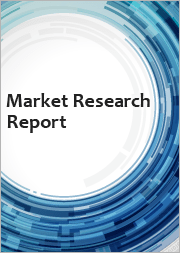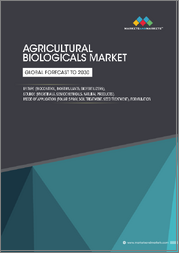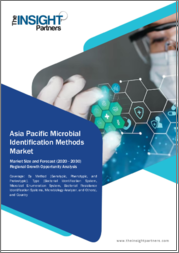
|
시장보고서
상품코드
1481978
아시아태평양의 미생물 동정법 시장 : 지역별 분석 - 방법별, 유형별, 예측(-2030년)Asia Pacific Microbial Identification Methods Market Forecast to 2030 - Regional Analysis - By Method and Type |
||||||
아시아태평양의 미생물 동정법 시장 규모는 2022년에 9억 4,727만 달러에 달하며, 2022-2030년 CAGR 8.7%로 성장하며, 2030년에는 18억 5,095만 달러에 달할 것으로 예측되고 있습니다.
미생물 동정 절차를 요구하는 식품 안전에 대한 관심의 증가가 아시아태평양의 미생물 동정법 시장을 지원
식품매개감염병(FBD)은 공중위생 및 경제 문제의 확산과 확산입니다. 식품 매개 감염의 유행은 최근 식품 생산 및 가공 방법의 변화와 소비자의 식습관 변화의 영향을 받고 있습니다. 감염시 알려진 병원체 간의 상호 작용은 우려되는 문제 중 하나이며, 최근 수년간 새로운 도전과제가 등장했습니다. 화학적 방부제와 콜드체인의 도입과 미생물에 대한 이해도가 높아졌음에도 불구하고 식중독은 선진국과 개발도상국 모두에게 심각한 공중보건 문제입니다. 식품안전클러스터는 매년 약 42만 명이 사망하고 6억 명 이상(전 세계 인구 10명 중 1명)이 오염된 식품을 섭취한 후 질병에 걸리며, 2022년 6월까지 약 3,300만 DALY가 손실될 것으로 추정하고 있습니다. 매년 410만 명이 식중독에 걸리고 12억 달러의 비용이 발생하는 것으로 추정되는 호주에서 식중독은 큰 문제가 되고 있습니다. 지난 20년간 호주에서는 살모넬라균에 의한 식중독이 크게 증가했으며, 유사한 여러 국가와 비교했을 때 감염률이 가장 높은 국가 중 하나입니다. 약 5만 6,200건의 살모넬라증이 보고되었으며, 이 중 2,100건이 입원, 15건이 사망한 것으로 추정됩니다. 이 중 72%는 식품에 의한 것으로 추정됩니다. 또한 아시아개발은행(Asian Development Bank)의 예측에 따르면 2021년에는 동남아시아에서 470만 명이 빈곤층에 속해 안전한 식품과 기타 필요한 것을 구하기 어려워질 것으로 예상하고 있습니다. 그 결과 동남아시아에서 식중독이 빈번하게 발생하고 있습니다.
기존의 접근 방식은 다양한 비선택적, 선택적 농축 기술을 사용하여 박테리아를 배양하고 생화학적 확인 등을 하는 방식이었습니다. 식품, 특히 생고기, 생선, 유제품, 채소 등 유통기한이 짧은 식품을 검사할 때 검출 시간이 큰 제약이 됩니다. 일부 새로운 검출 방법은 매트릭스 지원 레이저 탈이온화 이온화 비행시간법이나 초분광 영상과 같은 분광학적 접근법을 사용하고 있습니다. 이처럼 식중독 사례 증가는 아시아태평양의 미생물 동정법 시장을 주도하고 있습니다.
아시아태평양 미생물 동정법 시장 개요
아시아태평양은 중국, 인도, 일본, 말레이시아, 인도네시아, 한국 등의 국가로 구성되어 있습니다. Frontiers in Public Health에 발표된 연구(2023년)에 따르면 1990년 4억 1,430만 명에서 2019년 4억 8,890만 명으로 증가할 것으로 예상되며, 아시아태평양의 하기도 감염 환자 수가 가장 많은 지역은 동남아시아, 동아시아, 동남아시아입니다. 명으로 증가했으며, 남아시아, 동아시아, 동남아시아의 환자 수가 가장 많습니다. 마찬가지로 2021년 One Health Trust의 보고서에 따르면 동남아시아 인구는 아르보바이러스 감염증, 뎅기열, 뎅기열, 치쿤구니야, 일본뇌염, 그리고 계속 우려되는 인플루엔자 유행으로 인한 신흥 전염병과 함께 무시할 수 없는 열대성 질병에 취약한 것으로 나타났습니다. 또한 중국에서는 2020-2021년 사이 인간 브루셀라증 발생률이 급격히 증가할 것으로 보고되고 있습니다. 중국질병예방통제센터가 발표한 보고서에 따르면 2021년에는 2,083개 현급 단위에서 6만 9,767건의 브루셀라증 환자가 보고되어 2020년 대비 47.7%, 즉 4만 7,425건이 증가했으며, 2017년 중국 병원체 식별망(China PIN)이 개발되고 네트워크 실험실에서 세균성 병원체 데이터를 수집하여 감염병을 조기에 발견하고 추적할 수 있도록 지원했습니다.
인도의 감염병 부담은 높고, 환자는 주로 농촌에 거주하고 있습니다. 인도 보건가족복지부(MoHFW)에 따르면 인도 인구의 40% 이상이 결핵균을 보유하고 있습니다. 전 세계 결핵 발병률 중 다제내성 결핵과 HIV 결핵을 포함한 26% 이상이 인도 환자입니다. 또한 Institute for Health Metrics and Evaluation에 따르면 말레이시아와 인도네시아는 급성 기관지염과 폐렴과 같은 하기도 감염의 유병률이 높다고 밝혔습니다. 마찬가지로 PubMed Central에 게재된 연구(2023년)에 따르면 급성 설사병은 말레이시아의 주요 공중보건 문제이며, 연간 1,350만 건 이상의 사례가 보고되고 있습니다. 이 중 5% 정도는 5세 미만의 어린이가 앓고 있습니다. 이처럼 다양한 감염성 질환의 높은 유병률과 발병률 증가는 의약품 생산과 진단을 증가시켜 이 지역의 미생물 동정법에 대한 수요를 증가시킬 것입니다. 기타 아시아태평양의 여러 국가에서는 의약품 생산, 감염성 질환 진단, 아시아 국가들의 헬스케어 산업 개선을 위한 협력 관계 증가 등 수요 증가로 인해 시장이 크게 성장하고 있습니다. 싱가포르의 헬스케어 산업은 고도로 숙련된 노동력, 첨단 헬스케어 인프라, 유리한 정부 정책 구상로 인해 매우 발전하고 있습니다. 또한 싱가포르와 태국과 같은 국가들도 의료 시스템을 발전시켜 우수한 의료관광 목적지로 부상하고 있습니다. 이와 같이 아시아태평양의 진단 및 관련 의료 요구사항에 대한 수요는 향후 수년간 아시아태평양의 미생물 동정법 시장을 활성화시킬 것으로 예상됩니다.
아시아태평양 미생물 동정법 시장 매출 및 2030년까지의 예측(백만 달러)
아시아태평양 미생물 동정법 시장 세분화
아시아태평양 미생물 동정법 시장은 방법, 유형 및 국가에 따라 세분화됩니다.
방법론에 따라 아시아태평양 미생물 동정법 시장은 유전자형, 표현형, 프로테오유형으로 구분되며, 2022년에는 표현형 부문이 가장 큰 점유율을 차지할 것으로 예상됩니다. 유전자형 부문은 다시 기기, 키트, 시약으로 세분화됩니다. 표현형 부문은 기기, 키트 및 시약으로 세분화됩니다. 프로테오유형 부문은 기기, 키트, 시약으로 세분화됩니다.
유형별로 아시아태평양 미생물 동정법 시장은 세균 동정 시스템, 미생물 열거 시스템, 내성균 동정 시스템, 미생물 분석기, 기타로 분류됩니다. 박테리아 식별 시스템 부문이 2022년 가장 큰 점유율을 차지했습니다.
국가별로 아시아태평양 미생물 동정법 시장은 중국, 일본, 인도, 한국, 인도네시아, 말레이시아, 기타 아시아태평양으로 구분됩니다. 중국은 2022년 아시아태평양 미생물 동정법 시장을 장악했습니다.
Avantor Inc, Becton Dickinson and Co, bioMerieux SA, Bruker Corp, Danaher Corp, Merck KGaA, Molzym GmbH &Co KG, Shimadzu Corp, Thermo Fisher Scientific Inc는 중동 및 아프리카의 미생물 동정법 시장에서 사업을 운영하고 있는 대기업의 일부입니다.
목차
제1장 서론
제2장 주요 요약
- 주요 인사이트
제3장 조사 방법
- 조사 범위
- 2차 조사
- 1차 조사
제4장 아시아태평양의 미생물 동정법 시장 구도
- 아시아태평양의 PEST 분석
제5장 아시아태평양의 미생물 동정법 시장 - 주요 산업 역학
- 시장 촉진요인
- 미생물 동정법을 요구하는 식품 안전에 대한 관심의 증가
- 다양한 최종사용자에서 미생물 동정법의 수요 증가
- 시장 억제요인
- 자동 미생물 동정 시스템의 고비용
- 복잡한 규제 구조에 의한 신규 미생물 진단 검사 승인 프로세스의 지연
- 시장 기회
- 미생물 동정을 촉진하기 위한 정부의 구상과 자금 원조
- 향후 동향
- 미생물 동정 기술의 진보
- 영향 분석
제6장 미생물 동정법 시장 : 아시아태평양의 시장 분석
- 아시아태평양의 미생물 동정법 시장의 매출, 2020-2030년
제7장 아시아태평양의 미생물 동정법 시장 : 매출·예측(-2030년) : 방법별
- 아시아태평양의 미생물 동정법 시장의 매출 점유율, 방법별, 2022년·2030년(%)
- 유전자형
- 표현형
- 프로테오형
제8장 아시아태평양의 미생물 동정법 시장 : 매출·예측(-2030년) : 유형별
- 아시아태평양의 미생물 동정법 시장의 매출 점유율, 유형별, 2022년·2030년(%)
- 세균 동정 시스템
- 미생물 동정 시스템
- 내성균 동정 시스템
- 미생물 애널라이저
- 기타
제9장 아시아태평양의 미생물 동정법 시장 : 국가별 분석
제10장 아시아태평양의 미생물 동정법 시장의 산업 상황
- 아시아태평양의 미생물 동정법 시장에서의 성장 전략
- 무기적 성장 전략
- 유기적 성장 전략
제11장 기업 개요
- Avantor Inc
- Becton Dickinson and Co
- Danaher Corp
- bioMerieux SA
- Merck KGaA
- Thermo Fisher Scientific Inc
- Bruker Corp
- Shimadzu Corp
- Biolog Inc
- Molzym GmbH & Co KG
제12장 부록
KSA 24.05.27The Asia Pacific microbial identification methods market was valued at US$ 947.27 million in 2022 and is expected to reach US$ 1,850.95 million by 2030; it is estimated to grow at a CAGR of 8.7% from 2022 to 2030.
Increasing Food Safety Concerns Demanding for Microbial Identification Procedure Fuel the Asia Pacific Microbial Identification Methods Market
Foodborne diseases (FBD) are a prevalent and expanding public health and economic problem. The prevalence of foodborne infections is influenced by recent changes in food production and processing methods and consumers' ever-evolving eating patterns. The interaction between known pathogens during infection is one of the concerns, and new difficulties have emerged in recent years. Despite the rising adoption of chemical preservatives, cold chains, and a greater understanding of microbes, foodborne illnesses are a significant public health issue for both industrialized and developing nations. The Food Security Cluster estimates that each year, ~420,000 people die, and over 600 million people-nearly one in ten people worldwide-get sick after consuming contaminated food, resulting in a loss of 33 million DALYs in June 2022. With an estimated 4.1 million cases of foodborne illness each year and an estimated $1.2 billion in costs, foodborne disease is a major problem in Australia. Over the past 20 years, Australia has had a considerable increase in foodborne illness caused by Salmonella, and one of the highest rates of this infection when compared to several similar countries. An estimated 56,200 cases of salmonellosis were reported, of which 2,100 result in hospitalizations and 15 are fatal. Of these, 72% are considered to be foodborne. Also, according to Asian Development Bank projections, 4.7 million people in Southeast Asia were living in poverty in 2021, which made it more difficult for them to obtain safe food and other requirements. Foodborne disease is more common in Southeast Asia as a result of these.
The conventional approach is cultivating bacteria using a variety of nonselective and selective enrichment techniques, followed, among other things, by biochemical confirmation. The time-to-detection is a significant limitation when testing foods, especially those with short shelf lives like fresh meat, fish, dairy products, and vegetables. Several newer detection methods use spectroscopic approaches, such as matrix-assisted laser desorption ionization-time of flight and hyperspectral imaging protocols. Thus, the increase in cases of foodborne diseases is driving the Asia Pacific microbial identification methods market.
Asia Pacific Microbial Identification Methods Market Overview
Asia Pacific comprises countries such as China, India, Japan, Malaysia, Indonesia, South Korea, and others. The rising infectious diseases in Asia Pacific drive the growth of the Asia Pacific microbial identification methods market. According to a study published (2023) in Frontiers in Public Health, the number of incident cases of lower respiratory infections increased from 414.3 million in 1990 to 488.9 million in 2019, with South Asia, East Asia, and Southeast Asia having the largest incident cases. Similarly, according to the report by One Health Trust in 2021, the Southeast Asian population is vulnerable to neglected tropical diseases alongside emerging infectious diseases from arbovirus infections, dengue, chikungunya, Japanese encephalitis, and the continuing concern of influenza outbreak. Further, China reported an exponential rise in the incidence of human brucellosis from 2020 to 2021. As per a report published by the Chinese Center for Disease Control and Prevention, 69,767 brucellosis cases were reported from 2,083 county-level divisions in 2021, a 47.7% increase from 2020, i.e., 47,425. In 2017, the Chinese Pathogen Identification Net (China PIN) was developed to collect data on bacterial pathogens from the network laboratories to support the early detection and tracing of infectious diseases.
The infectious disease burden in India is high, and patients are mainly from the rural population. As per the Ministry of Health and Family Welfare (MoHFW), more than 40% of the population in India carry TB bacteria in their body. Out of the total incidence of TB worldwide, more than 26% are from India, including both multidrug-resistant TB and HIV TB cases. In addition, the Institute for Health Metrics and Evaluation stated that Malaysia and Indonesia have a high prevalence of lower respiratory infections such as acute bronchitis and pneumonia. Similarly, as stated in a study published (2023) in PubMed Central, acute diarrhea is a major public health problem in Malaysia, with more than 13.5 million cases reported annually. Out of these, ~5% of cases occur in children under five years. Thus, the high prevalence and rising incidence of various infectious diseases will increase pharmaceutical production and diagnostics, boosting the demand for microbial identification methods in the region. The market is witnessing significant growth in various countries in the rest of Asia Pacific due to the rising demand for pharmaceutical production, infectious disease diagnosis, and increasing collaborations to improve the healthcare industry in Asian countries. The healthcare industry in Singapore has evolved enormously due to the highly skilled workforce, advanced healthcare infrastructure, and favorable government policy initiatives. Countries such as Singapore and Thailand are also developing their healthcare systems and emerging as excellent medical tourism destinations. Thus, the demand for diagnostics and related healthcare requirements in the rest of Asia Pacific is expected to fuel the Asia Pacific microbial identification methods market in the coming years.
Asia Pacific Microbial Identification Methods Market Revenue and Forecast to 2030 (US$ Million)
Asia Pacific Microbial Identification Methods Market Segmentation
The Asia Pacific microbial identification methods market is segmented based on method, type, and country.
Based on method, the Asia Pacific microbial identification methods market is segmented into genotypic, phenotypic, and proteotypic. The phenotypic segment held the largest share in 2022. The genotypic segment is further subsegmented into instruments, kits, reagents. The phenotypic segment is further subsegmented into instruments, kits, reagents. The proteotypic segment is further subsegmented into instruments, kits, reagents.
By type, the Asia Pacific microbial identification methods market is segmented into bacterial identification system, microbial enumeration system, bacterial resistance identification systems, microbiology analyzer, and others. The bacterial identification system segment held the largest share in 2022.
Based on country, the Asia Pacific microbial identification methods market is segmented into China, Japan, India, South Korea, Indonesia, Malaysia, and the Rest Asia Pacific. China dominated the Asia Pacific microbial identification methods market in 2022.
Avantor Inc, Becton Dickinson and Co, bioMerieux SA, Bruker Corp, Danaher Corp, Merck KGaA, Molzym GmbH & Co KG, Shimadzu Corp, Thermo Fisher Scientific Inc are some of the leading companies operating in the Middle East & Africa microbial identification methods market.
Table Of Contents
1. Introduction
- 1.1 The Insight Partners Research Report Guidance
- 1.2 Market Segmentation
2. Executive Summary
- 2.1 Key Insights
3. Research Methodology
- 3.1 Coverage
- 3.2 Secondary Research
- 3.3 Primary Research
4. Asia Pacific Microbial Identification Methods Market Landscape
- 4.1 Overview
- 4.2 Asia Pacific PEST Analysis
5. Asia Pacific Microbial Identification Methods Market - Key Industry Dynamics
- 5.1 Market Drivers
- 5.1.1 Increasing Food Safety Concerns Demanding for Microbial Identification Procedure
- 5.1.2 Rising Demand for Microbial Identification Methods Across Various End Users
- 5.2 Market Restraints
- 5.2.1 High Cost of Automated Microbial Identification Systems
- 5.2.2 Delay in Approval Process of New Microbial Diagnostic Test Due to Complex Regulatory Framework
- 5.3 Market Opportunities
- 5.3.1 Government Initiatives and Funding to Promote Microbial Identification
- 5.4 Future Trends
- 5.4.1 Advancements in Microbial Identification Techniques
- 5.5 Impact Analysis:
6. Microbial Identification Methods Market - Asia Pacific Market Analysis
- 6.1 Asia Pacific Microbial Identification Methods Market Revenue (US$ Mn), 2020 - 2030
7. Asia Pacific Microbial Identification Methods Market - Revenue and Forecast to 2030 - by Method
- 7.1 Overview
- 7.2 Asia Pacific Microbial Identification Methods Market Revenue Share, by Method 2022 & 2030 (%)
- 7.3 Genotypic
- 7.3.1 Overview
- 7.3.2 Genotypic: Asia Pacific Microbial Identification Methods Market - Revenue and Forecast to 2030 (US$ Million)
- 7.3.2.1 Asia Pacific Microbial Identification Methods Market, by Genotypic Product, 2020-2030 (US$ Million)
- 7.3.2.2 Asia Pacific Microbial Identification Methods Market, by Genotypic Microbe Type, 2020-2030 (US$ Million)
- 7.4 Phenotypic
- 7.4.1 Overview
- 7.4.2 Phenotypic: Asia Pacific Microbial Identification Methods Market - Revenue and Forecast to 2030 (US$ Million)
- 7.4.2.1 Asia Pacific Microbial Identification Methods Market, by Phenotypic Product, 2020-2030 (US$ Million)
- 7.4.2.2 Asia Pacific Microbial Identification Methods Market, by Phenotypic Microbe Type, 2020-2030 (US$ Million)
- 7.5 Proteotypic
- 7.5.1 Overview
- 7.5.2 Proteotypic: Asia Pacific Microbial Identification Methods Market - Revenue and Forecast to 2030 (US$ Million)
- 7.5.2.1 Asia Pacific Microbial Identification Methods Market, by Proteotypic Product, 2020-2030 (US$ Million)
- 7.5.2.2 Asia Pacific Microbial Identification Methods Market, by Proteotypic Microbe Type, 2020-2030 (US$ Million)
8. Asia Pacific Microbial Identification Methods Market - Revenue and Forecast to 2030 - by Type
- 8.1 Overview
- 8.2 Asia Pacific Microbial Identification Methods Market Revenue Share, by Type 2022 & 2030 (%)
- 8.3 Bacterial Identification Systems
- 8.3.1 Overview
- 8.3.2 Bacterial Identification Systems: Asia Pacific Microbial Identification Methods Market - Revenue and Forecast to 2030 (US$ Million)
- 8.4 Microbial Enumeration Systems
- 8.4.1 Overview
- 8.4.2 Microbial Enumeration System: Asia Pacific Microbial Identification Methods Market - Revenue and Forecast to 2030 (US$ Million)
- 8.5 Bacterial Resistance Identification Systems
- 8.5.1 Overview
- 8.5.2 Bacterial Resistance Identification Systems: Asia Pacific Microbial Identification Methods Market - Revenue and Forecast to 2030 (US$ Million)
- 8.6 Microbiology Analyzers
- 8.6.1 Overview
- 8.6.2 Microbiology Analyzer: Asia Pacific Microbial Identification Methods Market - Revenue and Forecast to 2030 (US$ Million)
- 8.7 Others
- 8.7.1 Overview
- 8.7.2 Others: Asia Pacific Microbial Identification Methods Market - Revenue and Forecast to 2030 (US$ Million)
9. Asia Pacific Microbial Identification Methods Market - Country Analysis
- 9.1 Asia Pacific
- 9.1.1 Asia Pacific Asia Pacific Microbial Identification Methods Market by Country
- 9.1.1.1 China
- 9.1.1.1.1 China: Asia Pacific Microbial Identification Methods Market Revenue and Forecast to 2030 (US$ Mn)
- 9.1.1.1.2 China: Asia Pacific Microbial Identification Methods Market, by Method
- 9.1.1.1.2.1 China: Asia Pacific Microbial Identification Methods Market, by Genotypic Product, 2020-2030 (US$ Million)
- 9.1.1.1.2.2 China: Asia Pacific Microbial Identification Methods Market, by Genotypic Microbe Type, 2020-2030 (US$ Million)
- 9.1.1.1.2.3 China: Asia Pacific Microbial Identification Methods Market, by Phenotypic Product, 2020-2030 (US$ Million)
- 9.1.1.1.2.4 China: Asia Pacific Microbial Identification Methods Market, by Phenotypic Microbe Type, 2020-2030 (US$ Million)
- 9.1.1.1.2.5 China: Asia Pacific Microbial Identification Methods Market, by Proteotypic Product, 2020-2030 (US$ Million)
- 9.1.1.1.2.6 China: Asia Pacific Microbial Identification Methods Market, by Proteotypic Microbe Type, 2020-2030 (US$ Million)
- 9.1.1.1.3 China: Asia Pacific Microbial Identification Methods Market, by Type
- 9.1.1.2 Japan
- 9.1.1.2.1 Japan: Asia Pacific Microbial Identification Methods Market Revenue and Forecast to 2030 (US$ Mn)
- 9.1.1.2.2 Japan: Asia Pacific Microbial Identification Methods Market, by Method
- 9.1.1.2.2.1 Japan: Asia Pacific Microbial Identification Methods Market, by Genotypic Product, 2020-2030 (US$ Million)
- 9.1.1.2.2.2 Japan: Asia Pacific Microbial Identification Methods Market, by Genotypic Microbe Type, 2020-2030 (US$ Million)
- 9.1.1.2.2.3 Japan: Asia Pacific Microbial Identification Methods Market, by Phenotypic Product, 2020-2030 (US$ Million)
- 9.1.1.2.2.4 Japan: Asia Pacific Microbial Identification Methods Market, by Phenotypic Microbe Type, 2020-2030 (US$ Million)
- 9.1.1.2.2.5 Japan: Asia Pacific Microbial Identification Methods Market, by Proteotypic Product, 2020-2030 (US$ Million)
- 9.1.1.2.2.6 Japan: Asia Pacific Microbial Identification Methods Market, by Proteotypic Microbe Type, 2020-2030 (US$ Million)
- 9.1.1.2.3 Japan: Asia Pacific Microbial Identification Methods Market, by Type
- 9.1.1.3 India
- 9.1.1.3.1 India: Asia Pacific Microbial Identification Methods Market Revenue and Forecast to 2030 (US$ Mn)
- 9.1.1.3.2 India: Asia Pacific Microbial Identification Methods Market, by Method
- 9.1.1.3.2.1 India: Asia Pacific Microbial Identification Methods Market, by Genotypic Product, 2020-2030 (US$ Million)
- 9.1.1.3.2.2 India: Asia Pacific Microbial Identification Methods Market, by Genotypic Microbe Type, 2020-2030 (US$ Million)
- 9.1.1.3.2.3 India: Asia Pacific Microbial Identification Methods Market, by Phenotypic Product, 2020-2030 (US$ Million)
- 9.1.1.3.2.4 India: Asia Pacific Microbial Identification Methods Market, by Phenotypic Microbe Type, 2020-2030 (US$ Million)
- 9.1.1.3.2.5 India: Asia Pacific Microbial Identification Methods Market, by Proteotypic Product, 2020-2030 (US$ Million)
- 9.1.1.3.2.6 India: Asia Pacific Microbial Identification Methods Market, by Proteotypic Microbe Type, 2020-2030 (US$ Million)
- 9.1.1.3.3 India: Asia Pacific Microbial Identification Methods Market, by Type
- 9.1.1.4 South Korea
- 9.1.1.4.1 South Korea: Asia Pacific Microbial Identification Methods Market Revenue and Forecast to 2030 (US$ Mn)
- 9.1.1.4.2 South Korea: Asia Pacific Microbial Identification Methods Market, by Method
- 9.1.1.4.2.1 South Korea: Asia Pacific Microbial Identification Methods Market, by Genotypic Product, 2020-2030 (US$ Million)
- 9.1.1.4.2.2 South Korea: Asia Pacific Microbial Identification Methods Market, by Genotypic Microbe Type, 2020-2030 (US$ Million)
- 9.1.1.4.2.3 South Korea: Asia Pacific Microbial Identification Methods Market, by Phenotypic Product, 2020-2030 (US$ Million)
- 9.1.1.4.2.4 South Korea: Asia Pacific Microbial Identification Methods Market, by Phenotypic Microbe Type, 2020-2030 (US$ Million)
- 9.1.1.4.2.5 South Korea: Asia Pacific Microbial Identification Methods Market, by Proteotypic Product, 2020-2030 (US$ Million)
- 9.1.1.4.2.6 South Korea: Asia Pacific Microbial Identification Methods Market, by Proteotypic Microbe Type, 2020-2030 (US$ Million)
- 9.1.1.4.3 South Korea: Asia Pacific Microbial Identification Methods Market, by Type
- 9.1.1.5 Indonesia
- 9.1.1.5.1 Indonesia: Asia Pacific Microbial Identification Methods Market Revenue and Forecast to 2030 (US$ Mn)
- 9.1.1.5.2 Indonesia: Asia Pacific Microbial Identification Methods Market, by Method
- 9.1.1.5.2.1 Indonesia: Asia Pacific Microbial Identification Methods Market, by Genotypic Product, 2020-2030 (US$ Million)
- 9.1.1.5.2.2 Indonesia: Asia Pacific Microbial Identification Methods Market, by Genotypic Microbe Type, 2020-2030 (US$ Million)
- 9.1.1.5.2.3 Indonesia: Asia Pacific Microbial Identification Methods Market, by Phenotypic Product, 2020-2030 (US$ Million)
- 9.1.1.5.2.4 Indonesia: Asia Pacific Microbial Identification Methods Market, by Phenotypic Microbe Type, 2020-2030 (US$ Million)
- 9.1.1.5.2.5 Indonesia: Asia Pacific Microbial Identification Methods Market, by Proteotypic Product, 2020-2030 (US$ Million)
- 9.1.1.5.2.6 Indonesia: Asia Pacific Microbial Identification Methods Market, by Proteotypic Microbe Type, 2020-2030 (US$ Million)
- 9.1.1.5.3 Indonesia: Asia Pacific Microbial Identification Methods Market, by Type
- 9.1.1.6 Malaysia
- 9.1.1.6.1 Malaysia: Asia Pacific Microbial Identification Methods Market Revenue and Forecast to 2030 (US$ Mn)
- 9.1.1.6.2 Malaysia: Asia Pacific Microbial Identification Methods Market, by Method
- 9.1.1.6.2.1 Malaysia: Asia Pacific Microbial Identification Methods Market, by Genotypic Product, 2020-2030 (US$ Million)
- 9.1.1.6.2.2 Malaysia: Asia Pacific Microbial Identification Methods Market, by Genotypic Microbe Type, 2020-2030 (US$ Million)
- 9.1.1.6.2.3 Malaysia: Asia Pacific Microbial Identification Methods Market, by Phenotypic Product, 2020-2030 (US$ Million)
- 9.1.1.6.2.4 Malaysia: Asia Pacific Microbial Identification Methods Market, by Phenotypic Microbe Type, 2020-2030 (US$ Million)
- 9.1.1.6.2.5 Malaysia: Asia Pacific Microbial Identification Methods Market, by Proteotypic Product, 2020-2030 (US$ Million)
- 9.1.1.6.2.6 Malaysia: Asia Pacific Microbial Identification Methods Market, by Proteotypic Microbe Type, 2020-2030 (US$ Million)
- 9.1.1.6.3 Malaysia: Asia Pacific Microbial Identification Methods Market, by Type
- 9.1.1.7 Rest of Asia Pacific
- 9.1.1.7.1 Rest of Asia Pacific: Asia Pacific Microbial Identification Methods Market Revenue and Forecast to 2030 (US$ Mn)
- 9.1.1.7.2 Rest of Asia Pacific: Asia Pacific Microbial Identification Methods Market, by Method
- 9.1.1.7.2.1 Rest of Asia Pacific: Asia Pacific Microbial Identification Methods Market, by Genotypic Product, 2020-2030 (US$ Million)
- 9.1.1.7.2.2 Rest of Asia Pacific: Asia Pacific Microbial Identification Methods Market, by Genotypic Microbe Type, 2020-2030 (US$ Million)
- 9.1.1.7.2.3 Rest of Asia Pacific: Asia Pacific Microbial Identification Methods Market, by Phenotypic Product, 2020-2030 (US$ Million)
- 9.1.1.7.2.4 Rest of Asia Pacific: Asia Pacific Microbial Identification Methods Market, by Phenotypic Microbe Type, 2020-2030 (US$ Million)
- 9.1.1.7.2.5 Rest of Asia Pacific: Asia Pacific Microbial Identification Methods Market, by Proteotypic Product, 2020-2030 (US$ Million)
- 9.1.1.7.2.6 Rest of Asia Pacific: Asia Pacific Microbial Identification Methods Market, by Proteotypic Microbe Type, 2020-2030 (US$ Million)
- 9.1.1.7.3 Rest of Asia Pacific: Asia Pacific Microbial Identification Methods Market, by Type
- 9.1.1.1 China
- 9.1.1 Asia Pacific Asia Pacific Microbial Identification Methods Market by Country
10. Asia Pacific Microbial Identification Methods Market Industry Landscape
- 10.1 Overview
- 10.2 Growth Strategies in the Asia Pacific Microbial Identification Methods Market
- 10.3 Inorganic Growth Strategies
- 10.3.1 Overview
- 10.4 Organic Growth Strategies
- 10.4.1 Overview
11. Company Profiles
- 11.1 Avantor Inc
- 11.1.1 Key Facts
- 11.1.2 Business Description
- 11.1.3 Products and Services
- 11.1.4 Financial Overview
- 11.1.5 SWOT Analysis
- 11.1.6 Key Developments
- 11.2 Becton Dickinson and Co
- 11.2.1 Key Facts
- 11.2.2 Business Description
- 11.2.3 Products and Services
- 11.2.4 Financial Overview
- 11.2.5 SWOT Analysis
- 11.2.6 Key Developments
- 11.3 Danaher Corp
- 11.3.1 Key Facts
- 11.3.2 Business Description
- 11.3.3 Products and Services
- 11.3.4 Financial Overview
- 11.3.5 SWOT Analysis
- 11.3.6 Key Developments
- 11.4 bioMerieux SA
- 11.4.1 Key Facts
- 11.4.2 Business Description
- 11.4.3 Products and Services
- 11.4.4 Financial Overview
- 11.4.5 SWOT Analysis
- 11.4.6 Key Developments
- 11.5 Merck KGaA
- 11.5.1 Key Facts
- 11.5.2 Business Description
- 11.5.3 Products and Services
- 11.5.4 Financial Overview
- 11.5.5 SWOT Analysis
- 11.5.6 Key Developments
- 11.6 Thermo Fisher Scientific Inc
- 11.6.1 Key Facts
- 11.6.2 Business Description
- 11.6.3 Products and Services
- 11.6.4 Financial Overview
- 11.6.5 SWOT Analysis
- 11.6.6 Key Developments
- 11.7 Bruker Corp
- 11.7.1 Key Facts
- 11.7.2 Business Description
- 11.7.3 Products and Services
- 11.7.4 Financial Overview
- 11.7.5 SWOT Analysis
- 11.7.6 Key Developments
- 11.8 Shimadzu Corp
- 11.8.1 Key Facts
- 11.8.2 Business Description
- 11.8.3 Products and Services
- 11.8.4 Financial Overview
- 11.8.5 SWOT Analysis
- 11.8.6 Key Developments
- 11.9 Biolog Inc
- 11.9.1 Key Facts
- 11.9.2 Business Description
- 11.9.3 Products and Services
- 11.9.4 Financial Overview
- 11.9.5 SWOT Analysis
- 11.9.6 Key Developments
- 11.10 Molzym GmbH & Co KG
- 11.10.1 Key Facts
- 11.10.2 Business Description
- 11.10.3 Products and Services
- 11.10.4 Financial Overview
- 11.10.5 SWOT Analysis
- 11.10.6 Key Developments
12. Appendix
- 12.1 About Us
- 12.2 Glossary of Terms






